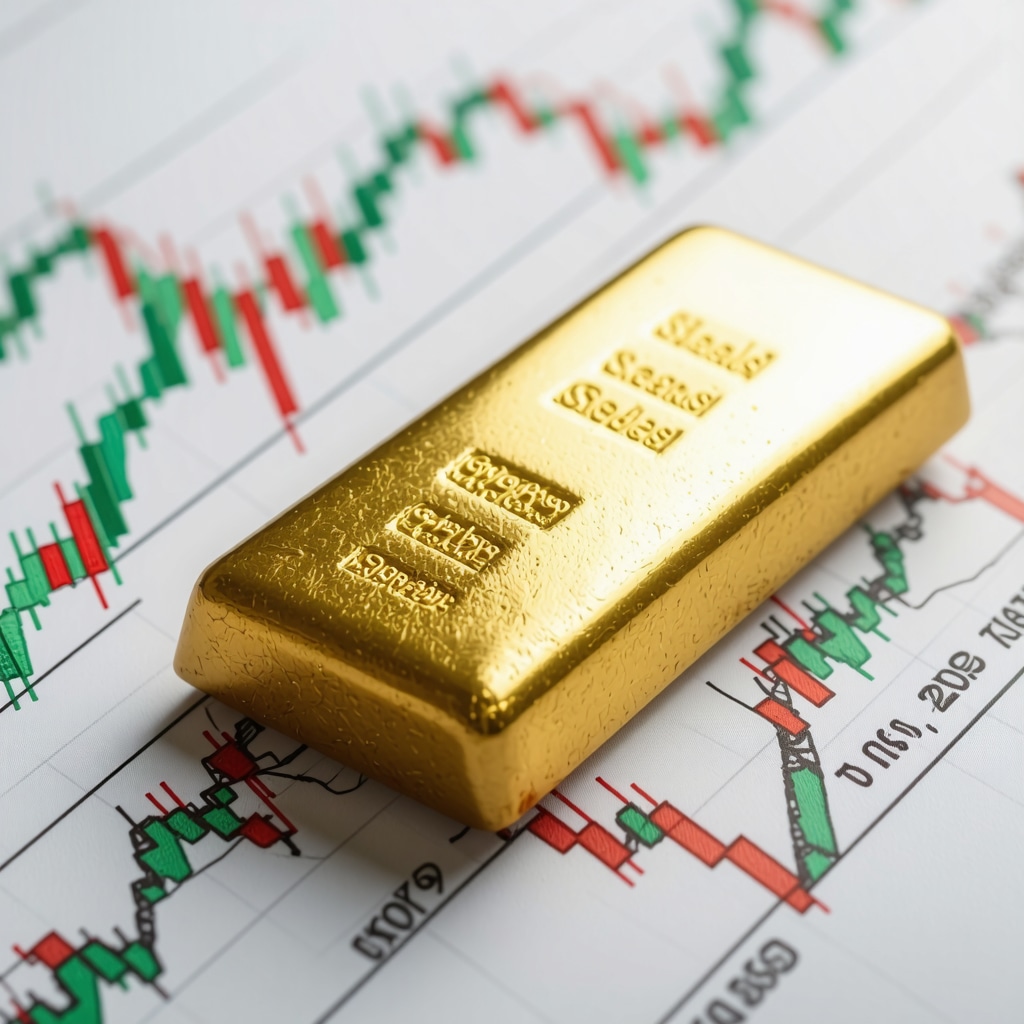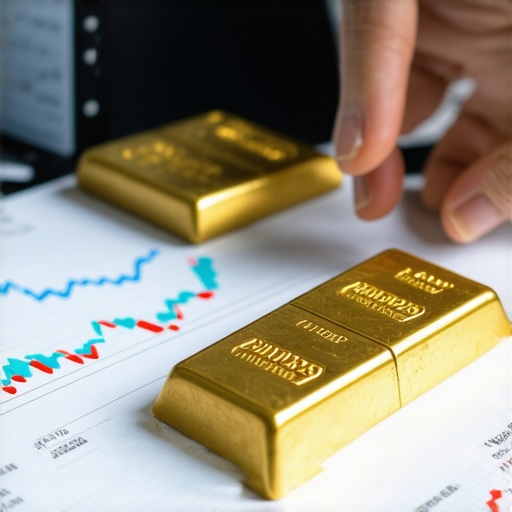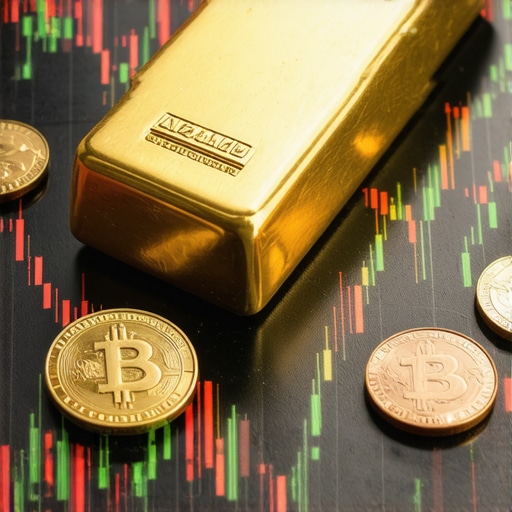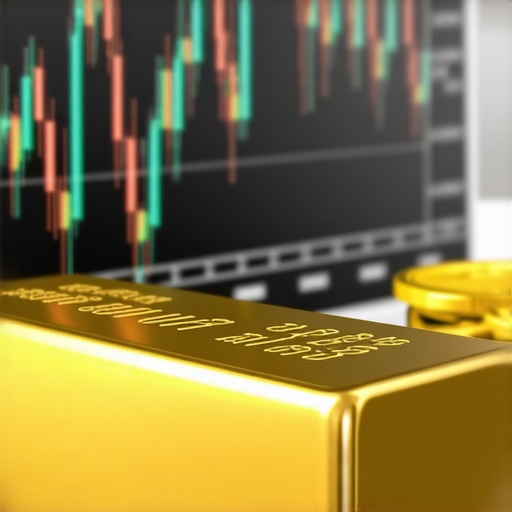Unveiling Gold’s Timeless Role Amid 2025’s Market Volatility
In an era marked by unprecedented economic shifts and geopolitical tensions, investors are increasingly turning to gold as a sanctuary against market uncertainty. The year 2025 brings its own unique challenges—rising inflationary pressures, fluctuating stock markets, and persistent global risks—that underscore gold’s enduring appeal. But what exactly makes gold a resilient hedge in these turbulent times? Exploring its multifaceted role reveals invaluable insights for savvy investors.
Golden Stability: Why Investors Flock to Gold When Markets Tremble
Gold’s intrinsic value stems not only from its scarcity but also from its historical performance as a store of wealth. Unlike fiat currencies, gold is impervious to central bank policies that often trigger inflation or currency devaluation. This characteristic makes it a strategic asset during periods of financial instability. For example, during the market downturn triggered by the COVID-19 pandemic, gold prices surged as investors sought refuge from volatile equities and bond yields.
Moreover, gold’s low correlation with stocks and bonds enhances portfolio diversification, reducing overall risk exposure. Its physical tangibility offers a psychological comfort absent in digital assets, especially when market trust wavers. Experts note that this tangible quality makes gold a preferred choice for those seeking to hedge against systemic risks and economic downturns.
How Does Gold Hedge Against Inflation and Currency Fluctuations in 2025?
This question probes the mechanics behind gold’s protective qualities in the face of inflation and currency instability.
Gold traditionally outpaces inflation because its supply is relatively fixed, unlike paper money which governments can print at will. When inflation erodes purchasing power, gold typically appreciates, preserving real value. In 2025, with inflation projections remaining elevated due to supply chain disruptions and expansive fiscal policies, gold’s role as an inflation hedge becomes even more critical.
Currency fluctuations also heighten uncertainty for global investors. Gold priced in US dollars often moves inversely to the dollar’s value. When the dollar weakens, gold becomes cheaper for holders of other currencies, boosting demand and stabilizing wealth internationally. This dynamic is particularly relevant as geopolitical tensions and central bank actions continue to impact forex markets.
Real-World Applications: Case Studies That Illuminate Gold’s Hedge Power
Consider the example of a diversified portfolio managed by an institutional investor in early 2025. As equity markets experienced volatility due to emerging geopolitical conflicts, a strategic allocation of 10-15% in physical gold and gold-backed ETFs helped smooth returns and limit losses. This practical approach underscores how blending gold with traditional assets can fortify portfolios.
Similarly, retail investors who purchased gold coins or bars during inflationary spikes reported better preservation of purchasing power compared to those fully invested in stocks or bonds. Such cases highlight the importance of choosing the right form of gold investment, whether physical bullion or financial instruments, to optimize hedging benefits.
Strategic Gold Investment: Navigating the Landscape in 2025
Choosing how to invest in gold requires nuanced understanding. Physical gold offers security but entails storage and liquidity considerations. Gold ETFs provide ease of trading but may lack the psychological comfort of tangible assets. For detailed strategies on safe gold acquisitions and portfolio integration, readers can explore smart gold investment strategies to protect wealth in 2025.
Seeking Deeper Insight? Explore the Dynamics of Gold Demand and Market Trends
Understanding the forces shaping gold prices in 2025 is crucial for making informed decisions. Factors like central bank gold purchases, jewelry demand, and technological uses create a complex demand landscape. For an authoritative perspective, the World Gold Council offers comprehensive reports that detail these trends and their price implications, which investors should consider for strategic planning (World Gold Council Research).
If you’re interested in how to start investing in gold or want to deepen your knowledge about gold market trends, feel free to share your thoughts or questions below. Engaging with a community of informed investors can sharpen your strategy and confidence.
When Gold Meets Modern Challenges: My Personal Take on Investment Decisions
Reflecting on my own journey with gold investments, I’ve found that the best decisions often come from not just understanding market theory but also appreciating the emotional and practical aspects of holding gold. For example, when I first bought physical gold bars, the tactile experience of owning something so tangible gave me a sense of security that no digital asset could match. This aligns with what many investors feel—a psychological hedge that goes beyond numbers.
However, owning physical gold also brought up challenges, especially around secure storage and liquidity. I remember debating whether to keep my gold at home, in a bank safety deposit box, or use a professional vaulting service. Each option had its trade-offs between convenience, cost, and safety. This decision-making process highlighted how critical it is to weigh not only the financial benefits but also the logistical realities of gold investments.
Gold ETFs vs. Physical Gold: Which Fits Your Investment Style Best?
One question I often hear is: “Should I buy physical gold or invest in gold ETFs?” From my experience and research, the answer depends largely on your investment goals and risk tolerance. Physical gold offers a direct hedge against market turmoil and inflation, but it requires careful handling and storage. On the other hand, gold ETFs provide liquidity and ease of trading, fitting well into a diversified portfolio without the hassle of physical custody.
For investors interested in exploring these options further, I recommend checking out this comprehensive guide comparing physical gold and ETFs which offers practical advice on which vehicle might suit your needs best.
How Do You Balance Emotional Comfort and Financial Strategy in Gold Investing?
This question often resonates with me because it touches on the very human side of investing. Gold is not just a commodity; it’s a symbol of security and stability. Yet, making emotionally driven decisions can sometimes cloud judgment. I’ve learned that blending personal comfort with disciplined financial strategy creates the most resilient investment approach. It’s about finding that sweet spot where your peace of mind aligns with smart portfolio management.
Staying Ahead: Leveraging Market Insights and Trusted Resources
To stay informed, I regularly consult authoritative sources like the World Gold Council and trusted investment platforms. Their research helps me understand how global trends, like central bank policies or shifts in jewelry demand, impact gold prices. For instance, recent reports emphasize that technological advancements, such as increased gold use in electronics, are subtly influencing demand, a factor often overlooked by casual investors (World Gold Council Research).
Keeping up with these insights enables me to make more nuanced decisions and adapt my strategy as market conditions evolve. If you’re curious about deepening your understanding, you might find this analysis of gold demand trends particularly enlightening.
Have you had experiences balancing physical gold and ETFs, or navigating the emotional versus strategic aspects of gold investing? Feel free to share your story or ask questions in the comments below. Engaging with others can provide fresh perspectives and help us all become smarter investors.
Decoding Gold’s Intricacies: Advanced Portfolio Optimization Techniques for 2025
As 2025 unfolds with its layered economic complexities, investors must transcend traditional approaches to gold allocation. Advanced portfolio optimization now integrates dynamic risk models that account for gold’s unique behavior during economic stress scenarios, including stagflation, currency crises, and shifting central bank policies. Employing quantitative techniques like Conditional Value-at-Risk (CVaR) and Monte Carlo simulations enables investors to precisely calibrate gold weights to buffer against tail risks without sacrificing long-term growth.
Moreover, integrating alternative data streams—such as satellite tracking of gold mining outputs and sentiment analysis from financial news—enriches predictive modeling for gold price movements. This intersection of big data and financial analytics represents the frontier for portfolio managers seeking alpha while maintaining resilient hedges.
Exploring Sophisticated Hedging: How Can Gold Serve as a Strategic Counterbalance to Emerging Market Volatility?
What nuanced mechanisms underlie gold’s effectiveness in mitigating risks specific to emerging market exposures?
Emerging markets inherently harbor elevated risks: currency devaluation, political upheaval, and liquidity constraints. Gold’s status as a globally recognized reserve asset provides these markets with a stabilizing ballast. Specifically, in portfolios with emerging market equities or sovereign bonds, gold often exhibits negative or near-zero correlation, enhancing risk-adjusted returns.
Research from the SSRN paper by Baur and Lucey (2019) elucidates that gold’s role as a safe haven is pronounced during episodes of extreme market stress, particularly in emerging economies. This protective function is not uniform; the timing and magnitude of gold’s hedge effectiveness vary depending on local currency depreciation and geopolitical shocks. Thus, a nuanced, context-specific gold strategy is essential for investors aiming to shield emerging market risks.
Technological Innovations and Their Impact on Gold Demand: A Deep Dive into 2025 Trends
While traditional drivers like jewelry and central bank reserves remain pivotal, technological advancements increasingly influence gold demand. The rise in medical devices, aerospace components, and high-performance electronics utilizes gold’s superior conductivity and corrosion resistance, steadily boosting industrial consumption.
In 2025, quantum computing research and next-generation semiconductor manufacturing are projected to intensify gold usage in microelectronics. This trend underlines a structural shift from cyclical demand to more stable, innovation-driven consumption. Recognizing this pivot allows investors to anticipate price support beyond traditional market cycles.
Practical Frameworks for Incorporating Gold into Multi-Asset Strategies
Integrating gold effectively demands more than static allocation percentages. Adaptive frameworks that respond to macroeconomic indicators—such as inflation surprises, real interest rate trajectories, and geopolitical risk indices—enable dynamic adjustments to gold exposure. Utilizing tactical overlays or employing options on gold futures can fine-tune risk management while capturing upside potential.
Additionally, investors should evaluate storage costs, liquidity profiles, and tax implications across different gold instruments. Physical gold’s custody requirements contrast with the convenience of ETFs, while gold mining equities introduce operational and geopolitical risks that may amplify returns or losses.
For those intrigued by sophisticated strategies, resources like the World Gold Council’s research on portfolio diversification provide nuanced insights into optimizing gold’s role in complex portfolios.
Have you experimented with dynamic gold allocations or integrated technological demand forecasts into your investment thesis? Join the conversation below to share your perspectives or delve deeper into these advanced strategies.
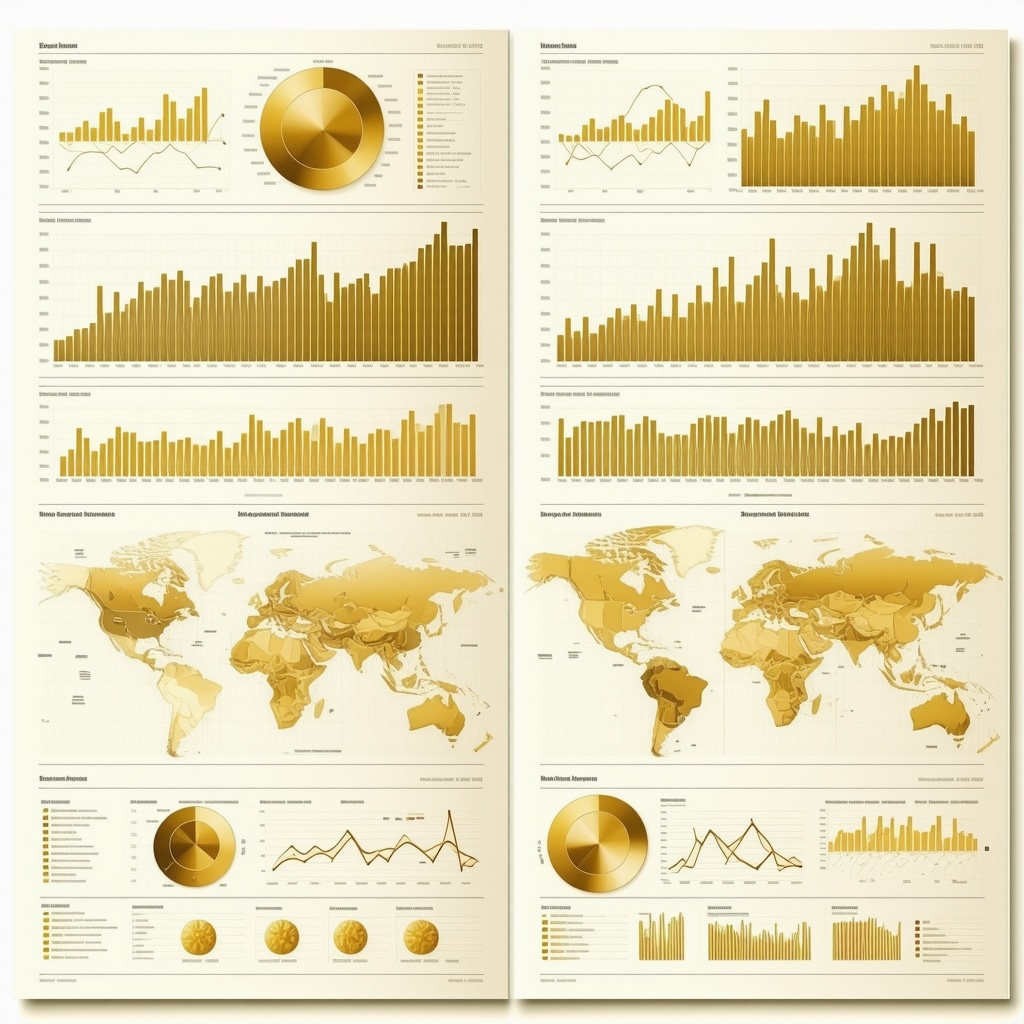
Harnessing Macro-Financial Indicators to Refine Gold Allocation
In 2025’s volatile macroeconomic environment, an astute investor leverages real-time data streams to calibrate gold exposure beyond traditional static models. By monitoring nuanced indicators such as breakeven inflation rates, shifts in Treasury yield curves, and geopolitical risk indices, portfolio managers dynamically adjust their gold holdings to optimize risk-adjusted returns. These adaptive allocation methodologies harness machine learning algorithms to identify early warning signals that precede market stress, enabling proactive hedging rather than reactive repositioning.
Innovative Analytical Tools Elevating Gold Price Forecasting Accuracy
Recent advances in computational finance have introduced alternative data analytics—ranging from satellite imagery assessing mining output to social media sentiment analysis—that enhance predictive accuracy for gold price trajectories. Integrating these unconventional data sources within multifactor econometric models has demonstrated improved forecasting horizons, especially when traditional fundamentals show ambiguity. This technological synergy empowers investors to anticipate supply-side disruptions or demand surges linked to industrial and geopolitical catalysts with greater confidence.
How Can Machine Learning Enhance Gold’s Role in Mitigating Portfolio Tail Risks?
Machine learning algorithms, particularly those focused on anomaly detection and regime classification, offer sophisticated approaches to modeling gold’s behavior during extreme market events. By identifying non-linear patterns and clustering market regimes based on volatility spikes or liquidity crunches, these models can optimize gold’s weight in portfolios to buffer against tail risks such as stagflation or currency collapses. Consequently, investors achieve a more resilient portfolio construct that is agile to evolving market dynamics.
Authoritative Insights from World Gold Council’s Latest Analytical Frameworks
The World Gold Council’s 2024 report on portfolio diversification underscores the importance of integrating advanced quantitative tools in gold investment strategies. Their empirical analyses reveal that portfolios incorporating dynamically adjusted gold allocations outperform static benchmarks during periods of heightened uncertainty, confirming gold’s pivotal role as a strategic hedge amid complex financial landscapes.
Engage with Cutting-Edge Gold Investment Methodologies Today
Elevate your investment acumen by embracing these advanced techniques that blend financial theory, data innovation, and practical strategy. Whether you manage institutional portfolios or personal wealth, adapting to 2025’s evolving market requires more than traditional gold allocation. Join our expert community to share insights, explore algorithmic approaches, and refine your gold investment blueprint for resilience and growth.
Frequently Asked Questions (FAQ)
Why is gold considered a reliable hedge against inflation in 2025?
Gold’s fixed supply contrasts with the expanding supply of fiat currencies, enabling it to preserve purchasing power when inflation erodes the value of money. In 2025, persistent inflationary pressures driven by supply chain disruptions and expansive fiscal policies reinforce gold’s role as a resilient inflation hedge.
How does gold interact with currency fluctuations in global portfolios?
Gold is typically priced in US dollars, so when the dollar weakens, gold becomes more affordable for holders of other currencies, increasing demand and stabilizing wealth internationally. This inverse correlation helps investors mitigate risks arising from currency volatility, especially in uncertain geopolitical environments.
Should I invest in physical gold or gold ETFs to hedge my portfolio?
Choosing between physical gold and gold ETFs depends on your investment goals, risk tolerance, and preferences. Physical gold offers tangible security and a psychological hedge but involves storage and liquidity considerations. Gold ETFs provide liquidity, ease of trading, and lower custody costs but lack physical possession. A balanced approach tailored to your needs often works best.
Can gold effectively hedge risks associated with emerging market investments?
Yes. Gold’s low or negative correlation with emerging market equities and bonds provides diversification benefits. It acts as a safe haven during currency devaluations and political instability common in emerging markets, though the hedge’s effectiveness varies depending on local conditions and timing.
How do technological advancements influence gold demand in 2025?
Beyond traditional uses like jewelry and reserves, gold’s demand is increasingly driven by technology sectors such as medical devices, aerospace, and advanced electronics. Innovations in quantum computing and semiconductor manufacturing are expected to boost industrial gold consumption, providing structural support to gold prices.
What advanced methods are available for optimizing gold allocation in portfolios?
Investors can use dynamic allocation frameworks that respond to macroeconomic indicators like inflation surprises and geopolitical risks. Quantitative tools such as Conditional Value-at-Risk (CVaR), Monte Carlo simulations, and machine learning models analyzing alternative data enhance the precision of gold’s portfolio weight to manage tail risks effectively.
How can machine learning improve forecasting gold price movements?
Machine learning algorithms can detect non-linear patterns, market regime changes, and anomalies by integrating diverse data sources like satellite imagery and sentiment analysis. These insights improve prediction accuracy for supply disruptions and demand shifts, helping investors anticipate price trends with greater confidence.
What are the trade-offs between liquidity and security when investing in gold?
Physical gold offers security and tangibility but requires secure storage, potentially higher costs, and less liquidity. Gold ETFs and mining equities provide higher liquidity and ease of access but expose investors to counterparty risk, market volatility, and operational risks. Understanding these trade-offs is crucial for aligning gold investments with your portfolio strategy.
How do macro-financial indicators guide dynamic gold allocation?
Indicators such as breakeven inflation rates, Treasury yield curve shifts, and geopolitical risk indices provide real-time signals to adjust gold exposure proactively. By leveraging these data streams, investors can optimize risk-adjusted returns and enhance portfolio resilience amid evolving market conditions.
What role does the World Gold Council play in gold investment research?
The World Gold Council provides authoritative, data-driven research on gold demand, market trends, and portfolio diversification strategies. Their analytical frameworks and reports help investors understand gold’s multifaceted role and integrate it effectively into modern investment portfolios.
Trusted External Sources
- World Gold Council (WGC): The leading authority on gold market data, trends, and investment research, offering comprehensive reports on gold’s role in portfolios, demand drivers, and price dynamics relevant for 2025.
- Social Science Research Network (SSRN) – Baur and Lucey (2019): A seminal academic paper analyzing gold’s safe haven properties, especially regarding emerging market volatility, providing empirical evidence for nuanced hedging strategies.
- International Monetary Fund (IMF): Offers macroeconomic data and analyses on inflation, currency fluctuations, and global financial stability, essential for understanding gold’s macro-financial context.
- Federal Reserve Economic Data (FRED): Provides real-time economic indicators such as inflation rates, Treasury yields, and currency indexes enabling dynamic gold allocation decisions.
- Specialized Financial Analytics Platforms (e.g., Bloomberg Terminal, Refinitiv): These platforms offer alternative data analytics, including satellite mining output and sentiment analysis, enhancing gold price forecasting accuracy.
Conclusion
Gold’s timeless stature as a hedge against inflation, currency volatility, and market turbulence remains highly relevant in 2025’s complex financial landscape. Its unique characteristics—scarcity, low correlation with conventional assets, and rising technological demand—offer investors a dynamic tool for portfolio resilience. Advanced analytical techniques, from machine learning to adaptive macro-financial models, empower investors to optimize gold allocations with precision, balancing security, liquidity, and growth potential. Whether through physical bullion, ETFs, or sophisticated derivatives, integrating gold thoughtfully can mitigate tail risks and enhance long-term wealth preservation.
As the market environment evolves, staying informed through trusted research and engaging with expert communities is vital. We encourage you to share your insights, ask questions, and explore further expert content to refine your gold investment approach and fortify your financial future.






